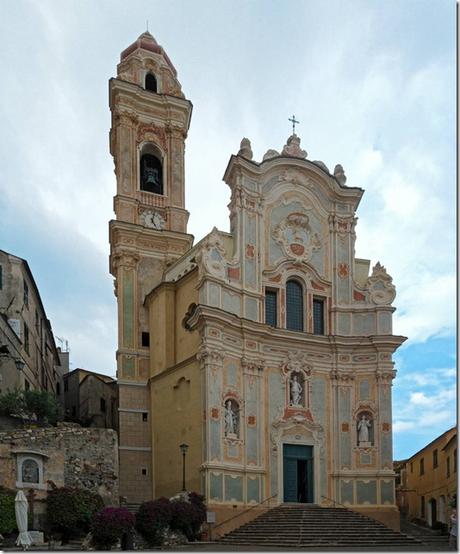
Cervo cannot exist without music. So, while waiting for the Festival, it offers a fascinating musical proposal to discover the artistic heritage of the village: sacred music, Italian bel canto and profane music, with the most famous melodies from the world of cinema. The concerts will take place in the Church of San Giovanni Battista and in the Oratory of Santa Caterina.
The church of San Giovanni Battista is a Catholic place of worship located in the municipality of Cervo, in via 11 Febbraio, in the province of Imperia. The building is the seat of the parish of the same name of the vicariate of Diano Marina of the diocese of Albenga-Imperia.
The internal nave
The church, dedicated to Saint John the Baptist, was built between the 17th and 18th centuries[1]. The building is also known by the local name "dei Corallini", because it was built thanks to the proceeds of coral fishing, and is considered one of the major Baroque monuments on the western coast.
The construction project was entrusted in 1686 to the architect Gio Batta Marvaldi who, however, did not see the work completed due to his death in 1706. His son Giacomo Filippo Marvaldi then took over the direction of the works and completed the work around 1722, even though other finishing works on the building still had to be completed. The official consecration of the church, officiated by the bishop of Aleria, Monsignor Camillo De Mari, dates back to 29 July 1736.
In the following years, other works connected to the parish were carried out[1], such as the square in front and the access staircase (1748); followed by decorations and stuccos from 1757 to 1763, the decoration of the façade in 1768 by Michele Mazzetti and the construction of the bell tower, erected in 1771 based on a design by the painter Francesco Carrega of Porto Maurizio.
Description
The interior of the church[1], with a single nave, consists of a good number of side altars and chapels. The first, on the right side, is dedicated to Saint Nicholas of Tolentino where there is a canvas, by an unknown painter, which portrays the saint miracle worker; the next is dedicated to the Souls in Purgatory and was created in 1772 by the Genoese sculptor Bernardo Gaggino and here are preserved, in the large niche, the wooden group of Saint John the Baptist (17th century) by Marcantonio Poggio, the statue of the Madonna del Rosario and that of the Immaculate, the latter work of the sculptor Anton Maria Maragliano.
Between 1763 and 1767, and again by Gaggino, the construction of the altar of Saint Anthony of Padua dates back to where an effigy of the saint of the same name is kept, by an unknown sculptor but attributable to the Genoese school of the 18th century; the marble worker Carlo Antonio Rippa from Loano was the creator of the subsequent altar dedicated to the Madonna del Rosario where the statue of the Madonna with Child is kept, a Genoese work by the sculptor Ratto who created it in the first half of the 17th century. At the top of the nave is the high altar, made by Antonio Pittaluga who then placed it in this church in 1759: above it stands out the wooden crucifix by Maragliano (or his workshop). Pittaluga himself created the next altar dedicated to Saint Erasmus, where a large altarpiece depicting the Virgin of Help with Saint Erasmus and Saint Clare, painted by Gio Lorenzo Bertolotto in 1736, is preserved. The next altar is dedicated to Saint Joseph and was created by Gaggino between 1779 and 1783; the last side altar of the church dedicated to the Conception dates back to 1937, despite the will of the inhabitants to dedicate it to the Assumption.
A white marble pulpit dating back to the 16th century adorns the parish church with sculpted panels depicting Saint George and Saint John the Baptist and, on the front, a Pietà. The tabernacle of the holy oils and the baptismal font date back to the 15th century, the first, and the second, to the 17th century. The organ is the work of Father Agostino Torrelli in 1735, and was later restored and expanded by Carlo Giuliani in 1844.
The frescoes of the apse vault were made by the painter Francesco Carrega; the other paintings of the vault were followed by Graffigna of Genoa after the earthquake of Diano Marina in 1887 which also caused some damage to the parish church and the village in Cervo.
